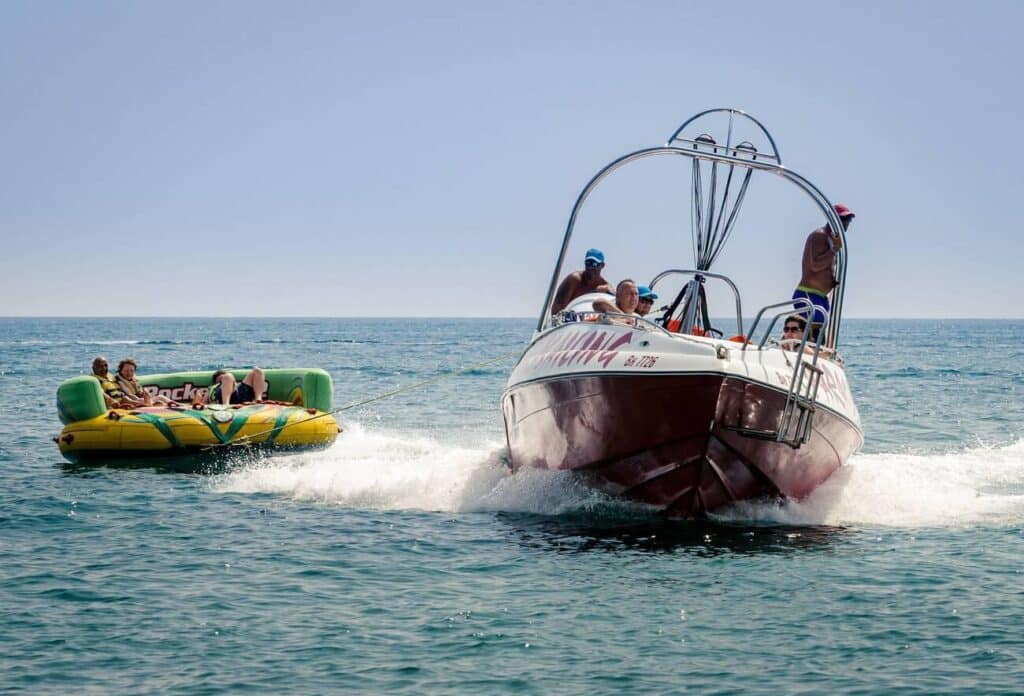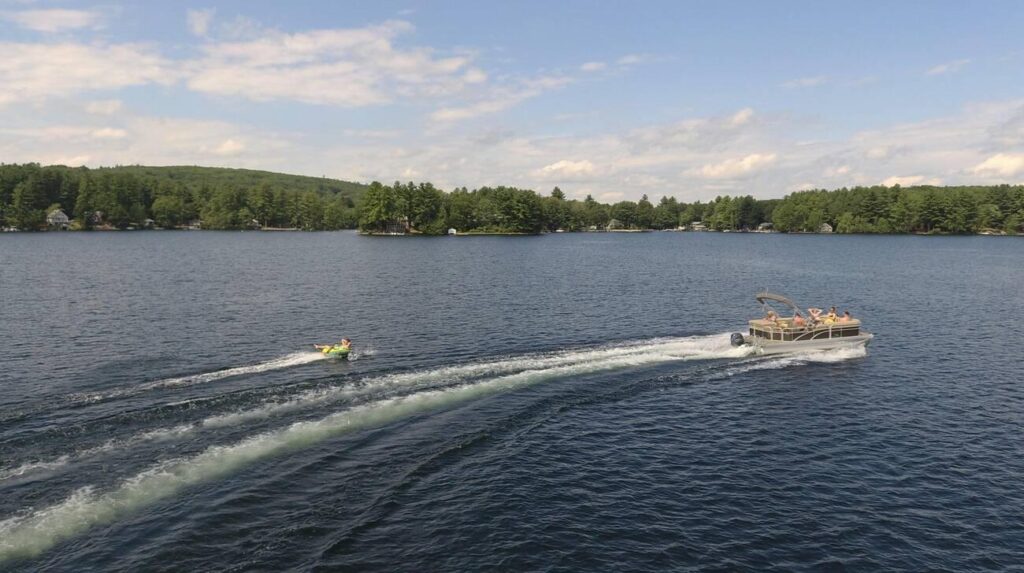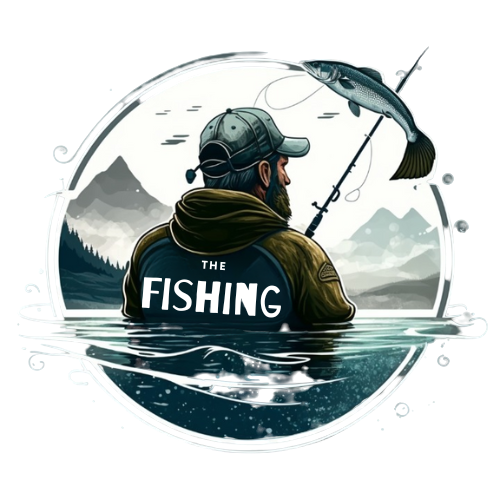Tubing behind a boat is an exhilarating experience that offers endless fun for both kids and adults. Whether you’re a seasoned boater or just starting out, knowing how to safely pull a tube behind your boat is essential.

This guide will walk you through the steps and best practices to ensure a safe and enjoyable tubing experience.
Table of Contents
Right Equipment To Pull A Tube Behind A Boat
Before you start, ensure you have the following equipment:
1. Towable Tube
Type: Choose a tube suitable for the number of riders. Tubes come in various designs, from single-rider tubes to multi-rider options.
Weight Capacity: Ensure the tube can handle the combined weight of all riders.
Features: Look for tubes with padded handles, knuckle guards, and a stable base for added safety and comfort.
2. Tow Rope
Material: The rope should be specifically designed for towing tubes. It should be strong, durable, and resistant to UV rays and abrasion.
Length: Most tow ropes for tubing range between 50 and 65 feet. The length you choose should provide enough distance between the boat and the tube for safety.
Strength: Ensure the rope can handle the weight and force exerted by the tube and riders. Check the rope’s weight capacity before purchasing.
3. Boat
Horsepower: Ensure your boat has sufficient horsepower to tow the tube, especially if you’re pulling multiple riders.
Tow Point: The boat should have a designated tow point, usually at the stern (back). If not, consider using a tow harness that attaches to the boat’s transom.
4. Life Jackets
Fit: Every rider should wear a life jacket that fits properly. It should be snug but comfortable.
Visibility: Bright-colored life jackets are recommended, especially for kids, as they are easier to spot in the water.
Certification: Ensure the life jackets are approved by relevant authorities for water safety.
5. Rearview Mirror (optional but recommended)
Purpose: A rearview mirror allows the boat driver to keep an eye on the tubers without turning around.
Attachment: If your boat doesn’t come with a built-in rearview mirror, consider attaching a temporary one. Ensure it provides a clear view of the tube and riders.
How to Pull a Tube Behind a Boat?

Here is a step by step guide:
Step 1: Choose a Suitable Location
The location plays a crucial role in ensuring a safe and enjoyable tubing experience. Opt for a spot with calm waters.
It’s advisable to choose a location that’s not too crowded, allowing the boat driver to maintain a consistent speed without frequent interruptions or the need to navigate around other watercraft.
Step 2: Prepare the Tube
Before you hit the water, take some time to prepare the tube. Inflate it according to the manufacturer’s guidelines, ensuring it’s firm but not over-inflated.
A quick inspection to check for any damages or punctures can prevent potential mishaps later on.
Step 3: Attach the Tow Rope
Connecting the tow rope correctly is vital for a safe tubing experience. One end of the rope should be securely attached to the tube, typically at a designated attachment point or harness.
The other end should be fastened to the boat’s stern. If your boat doesn’t have a specific point for this, a tow harness that attaches to the boat’s transom can be used.
Step 4: Safety First
Safety should always be at the forefront of any water activity.
Ensure that every rider is equipped with a life jacket that fits them properly.
The boat driver should have a clear view of the riders at all times, which is where a rearview mirror comes in handy.
Additionally, designate a spotter on the boat. This person’s role is to keep an eye on the riders and communicate with the boat driver, ensuring that any issues or needs of the riders are addressed promptly.
Step 5: Boarding the Tube
Once everything is set up, it’s time for the riders to board the tube.
They should enter the water slowly and ensure they’re seated comfortably on the tube with a firm grip on the tube’s handles.
Step 6: Start the Boat
With the riders ready, start the boat at a slow pace.
This ensures the tow rope becomes taut without jerking the riders abruptly.
Once the rope is taut, the boat driver can gradually increase the speed, always keeping in mind the comfort level of the riders and the tube’s specific guidelines.
Step 7: Maintain a Safe Speed
The speed at which you tow the tube plays a significant role in the safety and enjoyment of the riders.
For most tubing activities, a speed range of 15-25 mph is recommended. However, this can vary based on the riders’ experience and the tube’s design.
It’s essential for the boat driver to be attentive and adjust the speed based on the riders’ comfort and safety.
Step 8: Driving Patterns
While towing a tube, the boat driver should avoid making sharp turns, especially if the riders are new to tubing.
Wide and gentle turns give riders a fun experience without the risk of flipping the tube.
Being aware of the surroundings, including other boats and potential obstacles, is crucial to prevent accidents.
Step 9: Communication
Effective communication between the boat driver, the spotter, and the riders is essential for a safe tubing experience.
Establishing a set of hand signals for common messages like “speed up,” “slow down,” or “stop” can be beneficial.
The spotter plays a crucial role in relaying these messages to the boat driver, ensuring the riders’ needs are met.
Step 10: Ending the Ride
When it’s time to end the ride, the boat driver should reduce the speed gradually and steer the boat in a straight line.
This allows the tube to drift safely to the side of the boat. Once the boat has come to a complete stop, assist the riders in disembarking from the tube and boarding the boat.
Step 11: Safety Check and Storage
After the fun is over, it’s essential to conduct a safety check. Inspect the tube and tow rope for any signs of wear or damage.
Once everything is in order, deflate the tube, fold it, and store it in a dry place.
The tow rope should be coiled neatly to avoid tangles and stored separately.
Types of Boats Suitable for Tubing
When it comes to tubing, the type of boat you use plays a significant role in the overall experience. Here are some boats that are well-suited for towing tubes:
Bowriders: These are versatile boats that are perfect for recreational activities, including tubing. They offer ample seating and an open bow area, making them a popular choice for families.
Deck Boats: With a wide beam and a V-shaped hull, deck boats provide a stable and spacious platform, ideal for towing tubes and accommodating multiple passengers.
Ski Boats: Specifically designed for water sports, ski boats have powerful engines that can easily tow tubes, water skiers, and wakeboarders.
Pontoon Boats: While they are generally slower, pontoon boats with larger engines can be used for tubing, especially for younger or inexperienced riders who might prefer a gentler ride.
Cruisers: While not the first choice for many when it comes to tubing, cruisers with sufficient horsepower can also be used to tow tubes.
Jet Boats: Known for their agility and speed, jet boats can provide an exhilarating tubing experience. Their compact size and jet propulsion system make them suitable for quick turns and high-speed runs.
Center Console Boats: Primarily used for fishing, these boats can also be used for tubing when not on a fishing expedition. They offer a lot of deck space and can handle rougher waters.
You may also like to know: Can a Fishing Boat Pull a Tube? Find Out Now!
FAQs:
Can You Tow A Tube Behind A Boat?
Yes, you can tow a tube behind most types of boats equipped with sufficient horsepower.
What Speed Do You Pull A Tube Behind A Boat?
Typically, tubes are towed at speeds between 15-25 mph, depending on the riders’ experience and comfort.
What Is It Called When You Pull A Tube Behind A Boat?
Pulling a tube behind a boat is commonly referred to as “tubing” or “boat tubing.”
